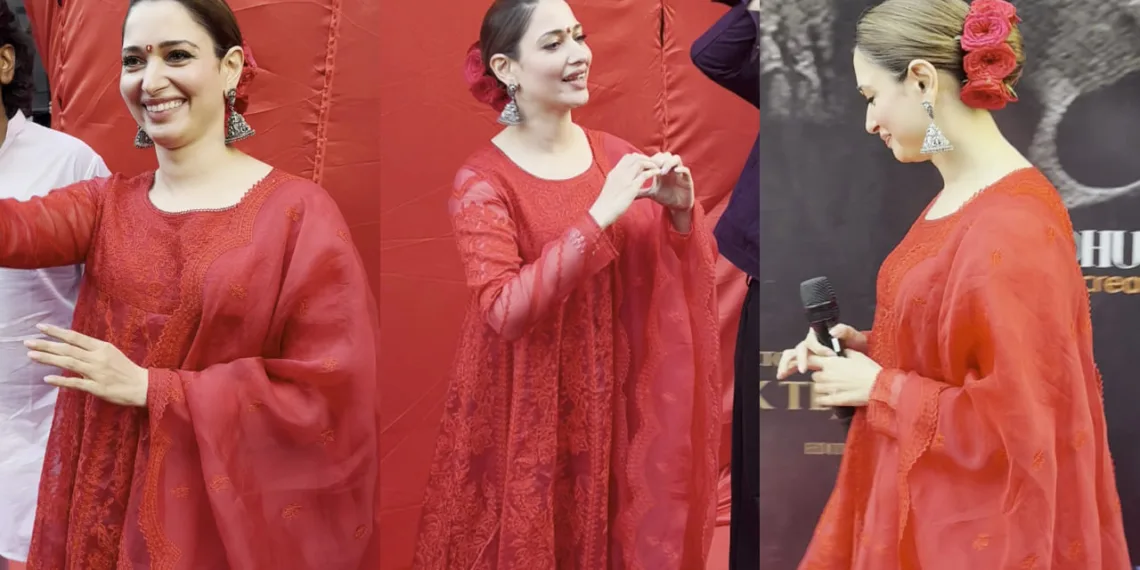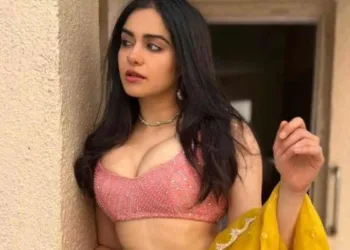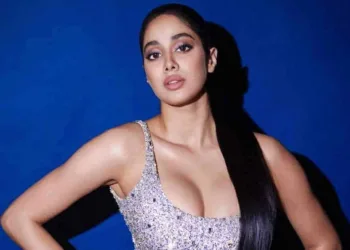The timeless allure of traditional Indian attire finds its perfect ambassador in Tamannaah Bhatia, whose recent promotional appearance for supernatural thriller “Odela 2” has captivated fashion enthusiasts nationwide. The actress, who has successfully straddled both South Indian cinema and Bollywood, continues to prove her sartorial prowess with thoughtfully curated ensembles that honor cultural heritage while making contemporary style statements. Her latest look—a resplendent red Anarkali embellished with intricate craftsmanship—pays homage to India’s rich textile traditions and exemplifies how traditional silhouettes remain relevant in modern celebrity wardrobes.
What elevated this particular appearance beyond conventional ethnic wear was Tamannaah’s romantic styling approach, particularly her decision to adorn her hair with fresh red roses—a detail that evoked the poetic sensibilities of a bygone era while perfectly complementing the thematic elements of her supernatural film. This harmonious blend of traditional craftsmanship, vibrant color, and nostalgic styling demonstrates the actress’s deep understanding of how fashion can enhance narrative storytelling.
Table of Contents
Tamannaah Bhatia Red Anarkali: A Masterclass in Traditional Elegance with Modern Appeal
Tamannaah Bhatia’s latest promotional appearance showcased the actress in a breathtaking custom Anarkali ensemble by acclaimed Indian designer Torani. The rich crimson creation seamlessly blended luxury and tradition, utilizing premium silk organza and handwoven chanderi fabrics to create a three-piece set that commanded attention while maintaining an air of timeless sophistication.

The centerpiece of the ensemble—a meticulously crafted kurta—featured a graceful scooped square neckline that framed her collarbones beautifully, while sheer long sleeves added an element of delicate romance. What truly distinguished this piece was the extraordinary aari embroidery work, which created tapestry-like patterns with intricate arabesque designs throughout the garment. This traditional needlework technique, executed with remarkable precision, transformed the red canvas into a narrative of artisanal excellence.
Completing the three-piece ensemble were matching flared pants that continued the same exquisite embroidery motifs, creating visual cohesion from top to bottom. The accompanying dupatta added movement and dimension to the look, draping elegantly to enhance the regal quality of the entire outfit. The synergy between these elements created a harmonious silhouette that honored traditional Anarkali proportions while feeling thoroughly contemporary.
| Element | Description | Cultural Significance |
|---|---|---|
| Fabric | Silk organza and handwoven chanderi | Heritage textiles with royal associations |
| Embroidery | Intricate aari work with arabesque patterns | Traditional technique dating back to Mughal era |
| Silhouette | Three-piece Anarkali with flared pants | Modern interpretation of classic formal attire |
| Color | Vibrant red | Auspicious shade in Indian culture, symbolizing power and passion |
| Hair Adornment | Fresh red roses | Traditional bridal and celebratory element in Indian styling |
| Jewelry | Silver oxidized statement jhumkas | Contrast to the outfit’s warmth, adding traditional dimension |
The “Sikandar ka Muqaddar” actress made thoughtful accessory choices that enhanced rather than competed with her striking ensemble. She opted for statement silver oxidized jhumka earrings—a deliberate choice that created beautiful contrast against the warm red tones of her outfit. The oxidized silver added an antique quality that reinforced the old-world aesthetic she was channeling, while the substantial size of the jhumkas ensured they remained visible despite the outfit’s inherent drama.

Perhaps the most enchanting element of Tamannaah’s styling was her decision to crown her updo with fresh red roses. This romantic detail transformed an already beautiful look into something truly memorable, creating a frame of natural crimson blooms around her sleek bun. The roses served multiple purposes: they complemented the red of her outfit perfectly, added a sensory dimension through their subtle fragrance, and created a visual connection to the supernatural themes of “Odela 2” by evoking traditions associated with divine worship in Indian culture.
The entire look demonstrated Tamannaah’s understanding of how fashion choices can support film promotion on multiple levels. By embracing the rich red hue and traditional craftsmanship, she visually connected to “Odela 2’s” themes of supernatural phenomena and divine powers, creating a stylistic bridge between her personal appearance and the film’s narrative world.
Bollywood Fashion Face-Off: Stars Choose Contrasting Styles at Maddock Films Gala
Frequently Asked Questions
What is the significance of red roses in traditional Indian hairstyling?
Red roses hold profound cultural significance in traditional Indian hairstyling, particularly within ceremonial and celebratory contexts. Historically, these fragrant blooms have been associated with divine feminine energy and are considered an offering to deities in temple rituals across India. When incorporated into hairstyling, as Tamannaah has done with her updo, roses create a connection to this spiritual tradition while adding natural beauty and sensory dimension through their perfume. In South Indian classical dance traditions like Bharatanatyam, which strongly influence regional film aesthetics, roses adorning a dancer’s hair represent purity and devotion.
This styling choice is particularly meaningful for Tamannaah’s “Odela 2” promotions since the film explores supernatural elements and divine powers—themes that align with the sacred associations of red roses in Indian culture. Beyond their spiritual significance, roses in hair arrangements have been documented in ancient Indian texts and paintings dating back centuries, making this not merely a fashion choice but a continuation of a deeply rooted cultural practice that connects contemporary celebrities to timeless traditions of feminine adornment.
How can one style an Anarkali outfit for different body types and occasions?
Styling an Anarkali outfit effectively requires understanding both body proportions and occasion appropriateness. For petite frames like Tamannaah’s, choose Anarkalis with vertical embroidery patterns and opt for ankle-length designs rather than floor-sweeping ones to create the illusion of height. Pair with heeled juttis or sandals for additional elevation. For fuller figures, empire waistlines and A-line silhouettes distribute volume elegantly, while strategic embroidery placement can create visual balance. When adapting Anarkalis for different occasions, consider fabric weight and embellishment level—silk organza and chanderi work beautifully for formal events like Tamannaah’s film promotion, while cotton Anarkalis suit casual gatherings.
For office settings, select subdued colors with minimal embellishment, paired with straight pants rather than flared ones. Wedding guest appearances call for richer fabrics and statement jewelry similar to Tamannaah’s oxidized silver jhumkas. The versatility of Anarkali sets also allows for creative mixing—the kurta can be paired with jeans for fusion styling, while the dupatta can transform a simple outfit into something special. Regardless of body type or occasion, proper tailoring remains essential for this silhouette to achieve the elegant flow and comfort that makes Anarkalis a perennial favorite in Indian fashion.








